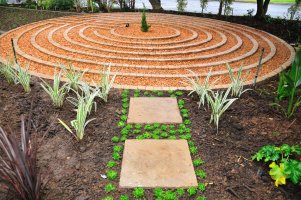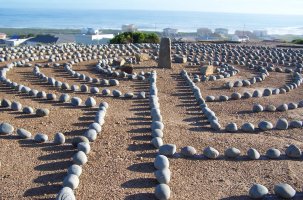A labyrinth is one of the oldest contemplative tools known to mankind and the perfect way to help you find inner peace and reconnect with yourself. Holistic healer and labyrinth facilitator Terry de Vries, who has been building labyrinths since 2002, introduces us to the mystery of labyrinths.
A labyrinth is one of the oldest contemplative tools known to mankind and the perfect way to help you cope with stress, solve problems, renew creativity and find inner peace. It can be walked anywhere at any time and helps you to reconnect with yourself.
But, what exactly is a labyrinth?
First of all, it is not a maze - something that even dictionaries seem to confuse.
A maze has twists and turns and blind alleys and is usually built with hedges. You can easily get lost in the puzzle that must be solved to eventually get to the centre.
A labyrinth, however, is a single, winding path that leads you from the entrance to the centre. You cannot get lost as the way in is the way out. It does not matter how intricate the labyrinth pattern may be, there is only a single route to the centre. Thus the only choice with a labyrinth is whether to enter or not.
Walking a labyrinth, you lose track of direction and of the outside world, and as a result achieve a contemplative state. It is therefore a form of walking meditation.
As you walk toward the centre of the labyrinth, you symbolically walk toward your personal spiritual centre. You initiate your journey/search from the outside and conclude it in the inside: the solution lies in the middle.
Why do people use labyrinths?
People come to labyrinths for many reasons and in many different ways. It can be many things: meditation, spiritual transformation, healing, grieving, stress reduction, family issues, work-related issues, problem solving, team building, leadership development, ritual or ceremony.
Labyrinths can be walked to connect with nature, to let go of the hectic modern life, to get rid of stress, to still the mind of thoughts, to let go of the past, to heal grief or trauma, to answer specific questions, to resolve conflict, to find inner peace, to live more consciously, to increase productivity, to become more creative, or just to chill out.
Whatever the reason, it is the beginning of a journey. A journey that eventually leads to inner peace.
What are the benefits?
Research in America concluded that people walking the labyrinth are more relaxed, peaceful and calm afterwards. They are also less angry or frustrated and get relief from emotional trauma and grief. After walking a labyrinth people can focus and concentrate better, and their intuition, imagination and creativity are stimulated.
The Harvard Medical School's Mind/Body Medical Institute found that focused walking meditations are highly efficient at reducing anxiety and elicits the relaxation response. This has significant long term health benefits, including lowered blood pressure, reduced incidents of chronic pain and a reduction of insomnia.
According to Daniel Pink, author of A Whole New Mind, a bestseller in management circles, we are moving from the information age to the conceptual age. "The purpose of life is the journey itself." He strongly believes the labyrinth is the tool for the future.
Why incorporate labyrinths in your workplace/garden?
Labyrinths add value to any place that is keen on holistic living as a way to improve the quality of life. As a contemplative tool, labyrinths offer an accessible and powerful way to relax and de-stress while cultivating inner peace. As land art, labyrinths enhance the natural beauty of the environment, especially if built by indigenous plants from the area.
"The labyrinth is truly a tool for our times. It can help us find our way through the bewildering multiplicity, to the unity of source. The labyrinth is an evocative experience. It provides the sacred space where the inner and outer worlds can commune, where the thinking mind and the imaginative heart can flow together. It can provide a space to listen to our inner voice of wisdom and come to grips with our role in humankind's next evolutionary step," writes Dr Lauren Artress in her book, Walking a Sacred Path: Rediscovering the Labyrinth as a Spiritual Tool.
Short history of labyrinths
The oldest known graphic representation of a labyrinth is carved on a piece of mammoth ivory. This was found in a Paleolithic tomb in Siberia and is older than 5000 BC.
Other early recordings of classical labyrinths are ancient rock carvings in Spain (2000 BC), Italy (750 BC) and Morocco (500 BC). Examples of classical labyrinths have also been found on ancient Greek coins from Crete (300 BC).
During the Roman Empire square mosaic labyrinths were built with more intricate patterns. Today some examples can still be seen at several museums throughout Europe, amongst others the Vienna and Pamplona museums.
During the Middle Ages, the classical labyrinth symbol was transformed to incorporate Christian symbology (i.e. the cross) and built in cathedrals. They were walked as a substitute for the long and arduous pilgrimage to Jerusalem. Of the 80 cathedrals in France and Italy during the Middle Ages, 22 of them had labyrinths.
The best known authentic example of an 11 circuit Medieval Labyrinth is the one in Chartres Cathedral, France, built in 1201. This labyrinth is the oldest walking-size labyrinth in the world and is still used today (although you can only walk it on Fridays as it is packed with chairs the other days).
The modern labyrinth revival, which started in the 1970s, has birthed labyrinths all around the world in public parks, private gardens, memorial gardens, universities, schools, hospitals, health care facilities, churches, religious communities, spa, retreat and wellness centres, prisons and businesses.
Jeff Saward, author of several labyrinth books, says: "Throughout the history of the labyrinth, whenever and wherever society is undergoing rapid change and development, the labyrinth has blossomed."
- (This article was written by Terry de Vries of Rainbow Labyrinths. For more information visit her website or contact her at terrydevries@mweb.co.za or 082 442 5623.)
(Images: Terry de Vries)
- (Health24, September 2010)




 Publications
Publications
 Partners
Partners












